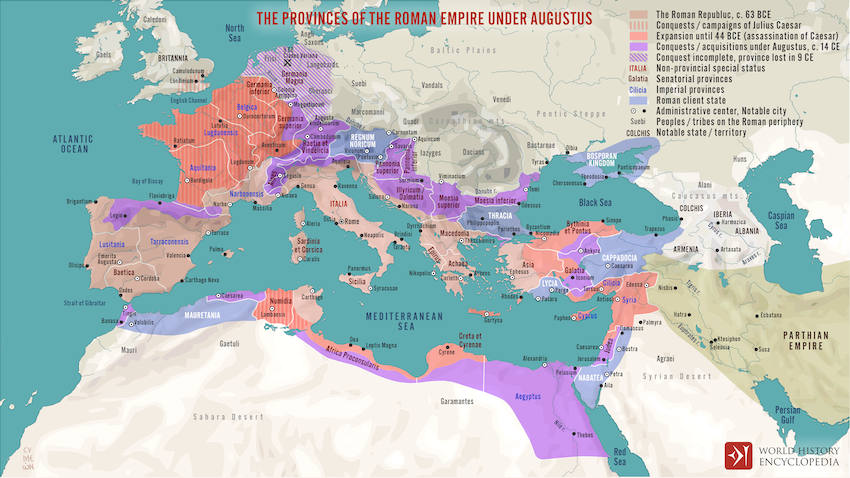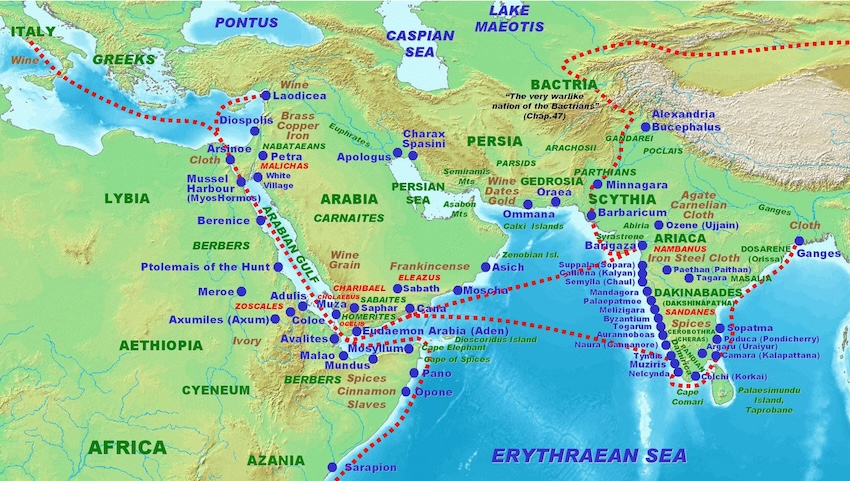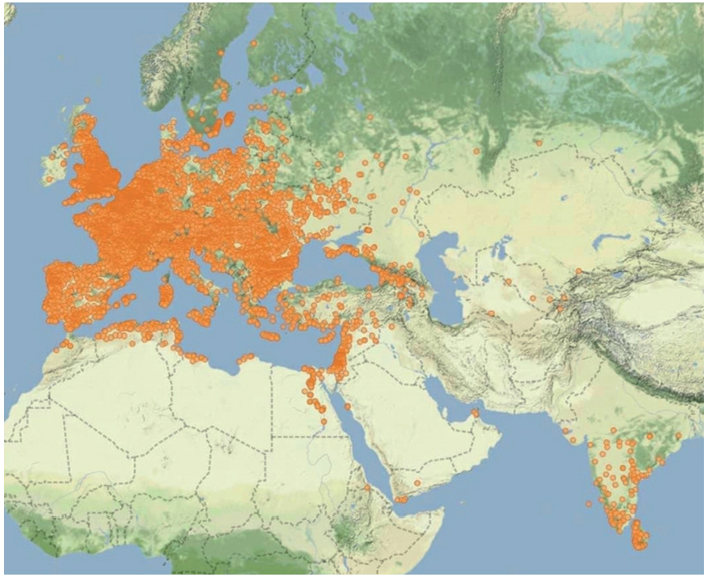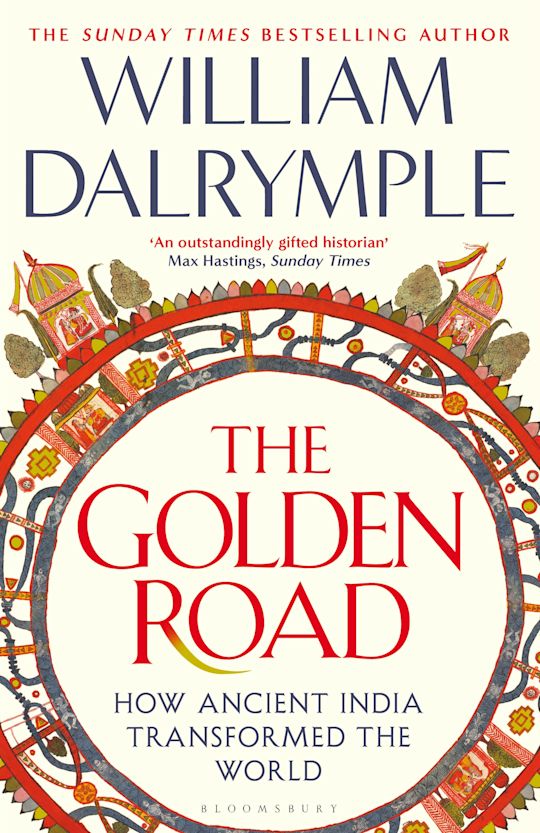We are so accustomed to viewing Christian origins within an exclusively Western orb. In our minds we have the images of a Roman Empire that stops abruptly at the Parthian border:

But what if we were to shift Italy a little further west with a view to imagining where Palestine and Egypt were positioned in the grand scheme of things?

Now try to register this newly emerging possibility:
Some economic historians now estimate that such was the scale of the Red Sea trade at this period [early imperial Rome] that the customs taxes raised by Roman officials on the trade coming through the Red Sea would alone have covered around one-third of the entire revenues that the Roman Empire required to administer its global conquests and maintain its legions, from Scotland to the borders of Persia and from the Sahara to the banks of the Rhine and Danube. . . .
Indeed according to some recent calculations, customs taxes on trade with India may have generated as much as one-third of the entire income of the Roman exchequer. . . . [A more cautious estimate by Andrew Wilson in his 2014 Cambridge Companion to the Roman Economy essay is that the quarter tax on the Red Sea ships amounted to a third of the annual cost of the army.]
Dalrymple, William. The Golden Road (pp. 6, 55, 318). Bloomsbury Publishing. Kindle Edition.
Compare this map of locations of Roman coin hoards:

It all began with Mark Antony’s defeat at the Battle of Actium and the establishment of Octavian’s/Augustus’s new imperial order. With the regular trade winds to and from India to the Red Sea a one way journey would take forty days:
Indian traders heading west used to arrive with the trade winds in early summer and ride the summer monsoon home in August; with the winds behind you, the journey from the mouth of the Red Sea to Gujarat could take as little as forty days, though if you missed the winds the round trip might take as long as a year, and cause you to take a prolonged holiday on the Nile.
Dalrymple, William. The Golden Road (p. 5). Bloomsbury Publishing. Kindle Edition.
And just as in more recent times we know Christian missionaries travelled with traders into South America and Africa, so did Buddhist monks travel to Roman ruled regions.
Hermann Detering broached the hypothesis that Buddhism was a significant player in the development of Christianity. I suspect few others have explored his arguments with much serious attention.
I wonder if a reconfiguration of our mental (and cultural) maps might encourage us to examine his thesis more closely. In my visits to different countries in south-east Asia I would always visit places of religious note and one scene always struck me: Buddha walking on water to his disciples just as Jesus…. as per these earlier posts:
https://vridar.org/2018/04/25/crossing-the-water-comparing-buddhist-and-christian-imagery/
https://vridar.org/2019/03/12/stories-of-walking-on-water-looking-for-sources/
But setting aside the question of Christian origins, the place of India in the history of the world in the past 2500 years is most definitely worth a major re-think: Please DO take a moment to listen to this podcast…..
Historian William Dalrymple on India’s Golden Road

The guest being interviewed in that podcast talks of several places I have visited — and his interview makes me want to return and re-explore those places.
How I would love to be on a committee today planning the history curriculum for school students. So much has been learned since I was in a classroom — the wide diversities of lifestyles and social organizations in prehistoric periods; how climate changes impacted civilizations; … and even the place of India as a fulcrum in world history — sending mathematical advances to the West and literature to the East. You will not regret taking the time to listen to the 50 or so minutes of that interview (pending your reading of the book in question).
Dalrymple, William. The Golden Road: How Ancient India Transformed the World. Bloomsbury Publishing, 2024.
If you enjoyed this post, please consider donating to Vridar. Thanks!

Hermann and Bob had the solution to the problem of the beginnings of Christianity right under their noses but they did not notice the obvious. Hermann and Bob postulated a late dating of the gospels and Paul’s letters, rightly. Hermann looked for sources in the Jewish-Buddhist-Greek Gnosticism, in Alexandria.
But in the end it turned out differently. The only written source of Christianity was TF, which met the messianic expectations of part of the audience. The news of the Messiah who appeared 65 years earlier and died and rose again started Christianity.
The rest is invented tradition.
https://drive.google.com/file/d/1-SuNSyBgzyhno7dQ_ZCo_CaaJeKMl6lu/view
Hello Neil, I also heard the ABC interview with William Dalrymple last week. I had read his superb recent book The Anarchy, on the history of the East India Company, in which for the first time a British historian used the Indian archive. He presents a welcome change from the Anglo-centrism of much previous history on India. There is an extensive scholarly literature, much despised and rejected by orthodox Christianity, on Buddhism’s relation to Christianity, such as the freely available book of that title by Michael Lockwood. Much of this has a speculative quality, but the weight of correlation between Buddhist sources and the Gospels is persuasive. It seems monasticism was brought to the West by Ashoka’s Buddhist missionaries in the third century BC, something not widely discussed. Of course the syncretic hypothesis of Indian influence was a key interest of my friend Acharya S, drawing partly from Theosophist traditions which tend to be ignored due to their mix of fact with speculation.
So you are a fellow LNL Gladys/poddie? (Readers not familiar with the radio series Late Night Live will have no idea what I’m talking about.) Yes — at heart I really wanted to do a post on the Dalrymple interview without any reference to Christianity, but felt I could not do it justice without investing more time than I had available.
It’s a program and a book that deserves to be widely known and discussed. — not only in the interests of fostering a better appreciation among Westerners towards India’s place in history and today, but also as a healthy corrective to a misguided branch of Modi’s Hindu nationalism.
Have you heard of Christian Lindtner? Link https://www.jesusisbuddha.com/index.html
And also of Prof. Michael Lockwood and his book Buddhism’s Relation to Christianity.
A prominent example from the website are to this Buddhist nonsensical.
1. The claim that Trinity derives from the Sanskrit phrase Triratna ignores the following facts: that the Trinity was a later development in Christianity from the 3rd century CE, meaning that it would have developed after Buddhism and Christianity allegedly split; that trinity and triratna use the same sounds because they are both derived from Indo-European words having to do with 3; that the Buddhist art representing the Triratna originated in an artistic context, while the Christian diagram representing the trinity arose among scholar/theologians as a teaching aid; the trinity is about how 3 gods are somehow 1 god and is said to be inexpliable to humans, but the triratna is a term of praise for 3 non-mystically related things (The Buddha, the Buddha’s teachings, and the Buddha’s followers, which are referred to as the 3 Jewels or Triratna in Sanskrit); the concept of multiple gods really being 1 god at some mystical level is actually more common in Hinduism with Brahma, Shiva, and Vishnu.
Flat maps always hurt my head because what looks small on one way to flatten the world looks big on another. Yeah that route doesn’t look that long on one map, but I can see in the ‘zoomed out’ ones you can put my country several times along the length of it. (Of course that’s why it was a sea route, trying to do that on foot/camel/horse would’ve been much more painful.) Point taken that there was definitely trade going on, and it didn’t have to take years to go to and from, and where there’s trade there’s exchange of ideas.
Michael Lockwood’s research on Buddhist influences begins with the diplomatic mission sent by Ashoka the Great (ca. 268-232 BCE), as documented in his stelae (specifically, the Major Rock Edict XIII), to several prominent locations in the Greek world (including Alexandria, ruled by “Tulamaya” [Ptolemy II Philadelphus]). He sets out arguments that the invention of the Brahman script of India took place at Alexandria under influence of scholarship there. Interesting reading, and seems possible, depending on exactly when the Brahman script was introduced (which is debated, but only by a matter of several decades).
He further hypothesizes that continuing Buddhist presence in Egypt later expressed itself in the monastic lifestyle of the Therapeutae, who were in turn influential on the development of Christianity, taking into account Detering and others.
Three comments.
(1) Young Lucius Annaeus Seneca (contemporary of St. Paul) was enamored with Yoga and vegetarian living (until his father insisted that he work in Rome where meat was mandatory). So, it’s plausible that Indian Religion had made an impact on the ancient Roman intelligentsia.
(2) Apollonius of Tyana, a healer and miracle-worker contemporary of Jesus, was reputed to have ties to Buddhism and Hinduism. Again, the ancient Roman intelligentsia seems to have been widely literate.
(3) Friedrich Nietzsche (1888, The Antichrist) regarded Jesus of Nazareth as a Buddhist type of personality. Not that Buddhism had come to Palestine — but that a specific sort of religion brings a hyper-sensitive feeling to life, favoring dropping-out into a quasi-monastic life.
This, said Nietzsche, was why Hinduism, Buddhism, and Christianity share a monastic, drop-out ideal that Nietzsche called “life-denying.”
In the Hellenistic Synagogues (e.g., Alexandria, Antioch, Tarsus) scholars can detect a thread of Neo-Platonism. If Plato, then why not a sliver of Yoga?
Takes only a little bit of lazy research raise your plausible to a highly likely!
https://en.wikipedia.org/wiki/Buddhism_and_the_Roman_world
Some interesting stories in the above, like the “a sramana who burned himself alive in Athens to demonstrate his faith” about 100 years before Peregrinus. A reminder that religious fanaticism is not limited to the big three!
What do you make of Rene Salm’s work on this?
I do love his research into the Yeshu narrative, but I feel that proposing that Yeshu was a historical person who converted to Buddhism is a bit of a thin limb of speculation. Nevertheless, it would be great if scholars could do more work on the Nazarene lead and the Yeshu legend, not sure if it will lead to Buddhism?
If the writers of the Q hypothesis document were Nazarenes, and it they gave us the Beatitudes, then I suppose that could be something.
PS – Hi to Rene if you are here under a pseudonym!
>Some interesting stories in the above, like the “a sramana who burned himself alive in Athens to demonstrate his faith” about 100 years before Peregrinus.
Indeed; such ritual immolations later developed within the sinosphere as manifestations of supreme faith in the salvific power of the Buddha Amitbha; the Buddhist monk who famously immolated himself in Vietnam had Aas his last words a mantra of faith in Amitabha Buddha.
In Japan, devotees of Amitabha Buddha following Shinran’s interpretation of the salvation offered by Amitabha Buddha were persecuted and executed at times by the government, which regarded Shinran’s interpretation of the salvation offered by Amitabha Buddha as dangerous because Shinran taught that even the worst people coulds avoid bad rebirths if they had faith in Amitabha Buddha and chanted honage to Amitabha Buddha 10 times. The Ikko-Ikki were miltant followers of a sect of followers of Amitabha Buddha who seized control over and rule 3 provinces in Japan for several decades; ttheir armies went forth under banners proclaiming their devotion to Amitabha Buddha.
I was researching Neoplatonism for a lecture at a local Philosophy Group, and noticed the rather close parallels between Plotinus’ (alleged founder of Neoplatonism, 3rd Century) description of meditation and union with what he called “The One” and descriptions of Bhuddhist practice. In the course of my research I came upon an article n Live Science on the excavation of Berenike, Roman Red Sea port, where a statue of the Buddha was found with an inscription dedicated to Roman Emperor “Phillip the Arab”.
I’m not sure of your policy on links, so I will not post any, but if interested go to livescience.com and type “1st-century Buddha statue from ancient Egypt”, should do the trick.
Of course this find does not prove any connection between Plotinus and Bhuddhists, but it is certainly suggestive.
Here is the link you spoke of: https://www.livescience.com/archaeology/ancient-egyptians/1st-century-buddha-statue-from-ancient-egypt-indicates-buddhists-lived-there-in-roman-times
Dalrymple writes of the Berenike finds as you would expect. An earlier Buddha statue found in the storeroom of the Isis Temple has been dated between 90 and 140 CE., most likely made in Alexandria and with Roman solar deity (Sol, Mithras) features. From the Wikipedia article for Berenike Buddha:
Fascianting. That would mean that the Berenike Buddha arose at the same time as many prominent early Mahayana Buddhist texts (early Perfection of Wisdom Literature) and early Christian writings (Ignatius, the Pastoral epistles, and probably Revelation to John if Witulski’s model be correct).
As they say, the victors write the histories and that is certainly true of the Roman Catholic Church. I am currently reading “The Lost History of Christianity: The Thousand-Year Golden Age of the Church in the Middle East, Africa, and Asia—and How It Died” by Philip Jenkins, which is making the same points you made here. Up until maybe 1400 the number of Christians outside of Europe was greater than the number inside.
I loved that book. Thanks for putting it in the context of Dalrymple’s latest publication. If I were on a board responsible for developing school history curricula I would want to make room for teaching history from a range of perspectives — Indian/South and Central Asia alongside the Western/European for starters….
It *is* interesting; I do like that map of coin hoards.
Inasmuch as “India” to a postHellenistic Iranian would mean the Indus, I don’t see the Roman influence there. The classical Vedic Hinduism will be more tied with Iran, I doubt I need to discuss the ties between the Samahita and the Avesta here.
But the Roman view of India was the Indian Ocean coast – as we see with these coins (iirc they even counted Oman with “India”). With an oceanic India, the Tamil / Kerala region is very much open to Rome. Being (1) maritime and (2) not in reach of hostile Iranians.
I don’t know the history of Buddhism in south India or Sri Lanka; Sri Lanka is highly Buddhist today. Krishnaism and other Dravidian popular expressions of old Hinduism will also be interrelated with Rome.
From my limited understanding, the traditional narrative about Buddhism’s history in Sri Lanka is very similar to Christianity’s traditional history, insofar as in tries to link Buddhism in Sri Lanka to famous past Buddhists ansd has long been accepted with little question. The claim is that the Sinhalese were converted to Buddhism by a son of Ashoka, and that a son and a daughter of Ashoka founded the Buddhist monastic order.
There are modern alternative interpretations of Buddhism’s history in Sri Lanka by Sinhalese Buddhists which are crazy and not taken seriously, relocating Buddhism’s origin to Sri Lanka.
Sri Lanka was in contact with Rome from the 1st Century BCE or so from my understanding, sending envoys to Augustus.
Nagarjuna and Aryadeva were apparently Mahayana Buddhists in India’s south from the 2nd century CE.
Russell Gmirkin and Robert Tulip referred to Michael Lockwood’s work on Buddhism and Christianity. Another Buddhist who has also studied the connections and posted about them of course is René Salm: https://www.mythicistpapers.com/buddhism-christianity/
What struck me as much as anything in the Dalrymple interview (and subsequently catching up with some references in his book) was the association of our zero with Buddhist concepts. I did not know that zero and our numeral system was invented in India and relayed to the West via (not ultimately from) the Arabs. Meanwhile, the “Latin of the East”, Sanskrit, was spearheaded a new literacy in east and south Asia from India, too.
Indian influence on Hellenistic era religion/cults is something I’ve been taking more seriously. It seems like a lot of western scholars (especially Christian e.g., NT scholars and people like Tom Holland) would be uncomfortable with this though.
Indeed. The cynical realist in me fears that there might be an element of “cultural disdain” underlying the discomfort. That’s why I would love everyone to become more attuned to the kind of information Dalrymple uncovers in his book. There is an ocean of room beckoning us to explore and learn to have a new respect for “the east”, for “Asia”.